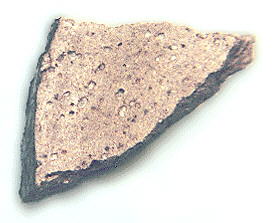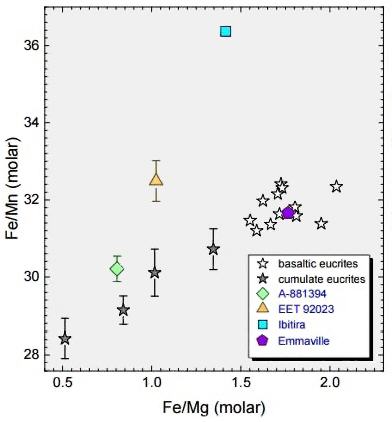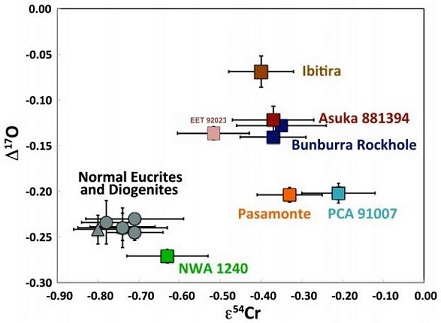Ibitira
Eucrite-like basaltic achondriteAn achondrite is a type of stony meteorite whose precursor was of chondritic origin and experienced metamorphic and igneous processes. They have a planetary or differentiated asteroidal origin where the chondritic parent body reached a sufficient size that through heating due to radioactive decay of 26Al (aluminum isotope) and gravitational Click on Term to Read More, ungroupedModifying term used to describe meteorites that are mineralogically and/or chemically unique and defy classification into the group or sub-group they most closely resemble. Some examples include Ungrouped Achondrite (achondrite-ung), Ungrouped Chondrite (chondrite-ung), Ungrouped Iron (iron-ung), and Ungrouped Carbonaceous (C-ung). Click on Term to Read More
(possible impact melt rockRock that has been made temporarily molten as a result of the energy released by the impact of a large colliding body. Impact melts include small particles, known as "impact melt spherules" that are splashed out of the impact crater, and larger pools and sheets of melt that collect in Click on Term to Read More)
Fell June 30, 1957
20° S., 45° W. approx. A fallMeteorite seen to fall. Such meteorites are usually collected soon after falling and are not affected by terrestrial weathering (Weathering = 0). Beginning in 2014 (date needs confirmation), the NomComm adopted the use of the terms "probable fall" and "confirmed fall" to provide better insight into the meteorite's history. If Click on Term to Read More occurred at 5:15 P.M. and one 2.5 kg stone was recovered in the village of Ibitira, near Martinho Campos, in Minas Gerais, Brazil. This is a unique, unbrecciated, vesicularVesicles appear in nature when they are produced within lava (extrusive aphanitic igneous rock) whose dissolved gases come out of solution (are released) due to the drop in pressure during an eruption. The resulting lava solidifies around the gas bubbles capturing their shape inside and outside the rock. Vesicles do Click on Term to Read More basaltic achondrite composed mainly of pyroxeneA class of silicate (SiO3) minerals that form a solid solution between iron and magnesium and can contain up to 50% calcium. Pyroxenes are important rock forming minerals and critical to understanding igneous processes. For more detailed information, please read the Pyroxene Group article found in the Meteoritics & Classification category. Click on Term to Read More in the form of pigeoniteLow-Ca clinopyroxene, (Ca,Mg,Fe)SiO3, found as a major mineral in eucrites and shergottites. In order to be considered pigeonite, the clinopyroxene must contain 5 to 20 mol % of calcium (Wo5 - 20). Chondrites of petrologic types 4 and below contain significant low-Ca clinopyroxene. During metamorphism to higher temperatures, all existing with exsolved augiteHigh-Ca clinopyroxene, (Ca,Mg,Fe)SiO3, that occurs in many igneous rocks, particularly those of basaltic composition. In order to be considered augite, the clinopyroxene must contain 20 to 45 mol % of calcium (Wo20 - 45). An important and unique Martian meteorite is NWA 8159, that has been classified as an augite basalt. Click on Term to Read More, along with plagioclaseAlso referred to as the plagioclase feldspar series. Plagioclase is a common rock-forming series of feldspar minerals containing a continuous solid solution of calcium and sodium: (Na1-x,Cax)(Alx+1,Si1-x)Si2O8 where x = 0 to 1. The Ca-rich end-member is called anorthite (pure anorthite has formula: CaAl2Si2O8) and the Na-rich end-member is albite Click on Term to Read More and tridymiteSilica group mineral in which the tetrahedra occur in sheets. Tetrahedra alternately point up or down to share oxygen with tetrahedra of other sheets, forming six-sided rings perpendicular the sheets. Tridymite has a fairly open structure and accommodates Na+, K+ and Ca2+; charge balance is achieved by Al3+ ↔ Si4+.. Minor ilmeniteTi-Fe oxide, TiFeO3, found in achondrites, lunar mare basalts, and shergottites. Ilmenite forms as a primary mineral in mafic igneous rocks. It crystallizes relatively early out of a magma before most of the other minerals, and as a result, the heavier crystals of ilmenite precipitate to the bottom of the magma Click on Term to Read More, chromiteBrownish-black oxide of chromium and iron (Cr-Fe oxide), Cr2FeO4, found in many meteorite groups. Click on Term to Read More, FeNi-metal, and troiliteBrass colored non-magnetic mineral of iron sulfide, FeS, found in a variety of meteorites. Click on Term to Read More are present. Ibitira has been historically grouped with the Stannern trend eucritesMost common type of achondrite meteorite and a member of the HED group. Eucrites are basalts composed primarily of pigeonite and anorthite (An60-98). Eucrites have been placed into three subgroups based on mineralogical and chemical differences. • Non-cumulate eucrites represent the upper crust that solidified on a magma ocean after Click on Term to Read More according to compositional similarities, such as its plot on a TiO vs. FeO/MgO diagram and its major and trace elementSubstance composed of atoms, each of which has the same atomic number (Z) and chemical properties. The chemical properties of an element are determined by the arrangement of the electrons in the various shells (specified by their quantum number) that surround the nucleus. In a neutral atom, the number of Click on Term to Read More ratios. However, a recent in-depth petrologic analysis of Ibitira was conducted by D. Mittlefehldt (2005), the results of which have led to the proposal that Ibitira was formed on a parent bodyThe body from which a meteorite or meteoroid was derived prior to its ejection. Some parent bodies were destroyed early in the formation of our Solar System, while others like the asteroid 4-Vesta and Mars are still observable today. Click on Term to Read More distinct from that of the HED suite basaltic achondrites (widely considered to be 4 VestaThird largest and fourth brightest asteroid; it was discovered in 1807 by Heinrich Olbers and named for the ancient Roman goddess of the hearth. 4 Vesta has a basaltic surface composition and an average density not much less than that of Mars. Evidently lava once flowed here indicating that the).
Diagnostic data for Ibitira (Mittlefehldt, 2005; Lentz et al., 2007), which show significant deviations from representative eucriteMost common type of achondrite meteorite and a member of the HED group. Eucrites are basalts composed primarily of pigeonite and anorthite (An60-98). Eucrites have been placed into three subgroups based on mineralogical and chemical differences. • Non-cumulate eucrites represent the upper crust that solidified on a magma ocean after Click on Term to Read More data, includes higher Fe/Mn (34–36 vs. 30 ±2) and lower Fe/Mg ratios in low-Ca pyroxene, aberrant O-isotope ratios, high Ti/Hf ratios, a volatile-rich composition, and a low alkali element content with a correspondingly high Ca content in plagioclase. While each of these factors taken individually might not definitively resolve Ibitira from the established eucrites or other known basaltic meteorites (e.g., O-isotope ratios for Ibitira are the same as those for angrites), when considered together they are diagnostic for the formation of Ibitira on a unique parent asteroid. As deduced by Scott et al. (2008), the high degree to which impact gardening has occurred on Vesta would suggest that Ibitira-like lithologies should be present in other HED meteorites, which is not the case. The compositional and isotopic similarities that exist among Ibitira, the eucrites, and the angrites suggest that they all likely formed from similar CV chondrite-like source material (similarly enriched in a refractory component) in relatively close proximity, but Ibitira and eucrites differentiated under reducingOxidation and reduction together are called redox (reduction and oxidation) and generally characterized by the transfer of electrons between chemical species, like molecules, atoms or ions, where one species undergoes oxidation, a loss of electrons, while another species undergoes reduction, a gain of electrons. This transfer of electrons between reactants Click on Term to Read More conditions while angrites differentiated under oxidizingOxidation and reduction together are called redox (reduction and oxidation) and generally characterized by the transfer of electrons between chemical species, like molecules, atoms or ions, where one species undergoes oxidation, a loss of electrons, while another species undergoes reduction, a gain of electrons. This transfer of electrons between reactants Click on Term to Read More conditions (Iizuka et al. (2015). McKibbin and O’Neill (2017) propose that the angriteType of evolved achondrite meteorite that represent some of the earliest stages of asteroidal differentiation and magmatism in our solar system. Angrites are named for the Angra dos Reis meteorite, which fell in Rio de Janeiro, Brazil, in early 1869. They are basaltic (mafic) rocks, often containing porous areas, and Click on Term to Read More parent body was originally stratified and heterogeneous with respect to chemical composition and redoxOxidation and reduction together are called redox (reduction and oxidation) and generally characterized by the transfer of electrons between chemical species, like molecules, atoms or ions, where one species undergoes oxidation, a loss of electrons, while another species undergoes reduction, a gain of electrons. This transfer of electrons between reactants Click on Term to Read More state, and that Ibitira could possibly represent a melt from a more reducedOxidation and reduction together are called redox (reduction and oxidation) and generally characterized by the transfer of electrons between chemical species, like molecules, atoms or ions, where one species undergoes oxidation, a loss of electrons, while another species undergoes reduction, a gain of electrons. This transfer of electrons between reactants Click on Term to Read More region on this planetesimal.
As presented by Sanborn and Yin (2014) [#2018], a Δ17O vs. ε54Cr diagram is one of the best available diagnostic tools for determining genetic (parent body) relationships between meteorites, constrained by the degree to which isotopic homogenization occurred on their respective parent bodies. Moreover, Sanborn et al. (2015) demonstrated that ε54Cr values are not affected by aqueous alteration. Currently, a number of anomalous eucritic meteorites are known, including Ibitira, Pasamonte, NWA 1240, PCA 82502/91007, Emmaville, Bunburra Rockhole, A-881394, EET 92023, each of which are resolved from typical eucrites and the HED parent body both isotopically and compositionally; notably, the latter three anomalous eucritic meteorites have close O-isotope values and might be related (Barrett et al., 2017, O-isotopic diagram 1; Mittlefehldt et al., 2018, O-isotopic diagram 2).
Another useful tool to help resolve potential genetic relationships among meteorites is the Fe/Mn ratio. While Fe and Mn do experience nebular fractionations they are not readily fractionated during parent body igneous processing, and therefore different Fe/Mn values are inherent in different parent objects. Mittlefehldt et al. (2017) utilized a number of eucrites and anomalous eucriteMost common type of achondrite meteorite and a member of the HED group. Eucrites are basalts composed primarily of pigeonite and anorthite (An60-98). Eucrites have been placed into three subgroups based on mineralogical and chemical differences. • Non-cumulate eucrites represent the upper crust that solidified on a magma ocean after Click on Term to Read More meteorites, including Ibitira, A-881394, EET 92023, and Emmaville, to compare the Fe/Mn and Fe/Mg ratios in low-Ca pyroxenes. Contrary to the O-isotopic results, these four meteorites plot in separate locations on an Fe/Mn vs. Fe/Mg coupled diagram, which suggests that they derive from separate parent bodies (see diagram below). Moreover, although Bunburra Rockhole and A-881394 have the same oxygenElement that makes up 20.95 vol. % of the Earth's atmosphere at ground level, 89 wt. % of seawater and 46.6 wt. % (94 vol. %) of Earth's crust. It appears to be the third most abundant element in the universe (after H and He), but has an abundance only Click on Term to Read More and chromium isotopeOne of two or more atoms with the same atomic number (Z), but different mass (A). For example, hydrogen has three isotopes: 1H, 2H (deuterium), and 3H (tritium). Different isotopes of a given element have different numbers of neutrons in the nucleus. Click on Term to Read More compositions, new in-depth analyses of Bunburra Rockhole conducted by Benedix et al. (2017, and references therein) have revealed that these two meteorites have very different textures and mineralInorganic substance that is (1) naturally occurring (but does not have a biologic or man-made origin) and formed by physical (not biological) forces with a (2) defined chemical composition of limited variation, has a (3) distinctive set of of physical properties including being a solid, and has a (4) homogeneous Click on Term to Read More chemistries; e.g., Bunburra Rockhole has plagioclase with An87–90, while A-881394 has plagioclase with An98. Based on their results, they consider it likely that these two meteorites derive from separate parent bodies. Further details about the anomalous eucrites can be found on the Pasamonte page.
Diagram adapted from Mittlefehldt et al., 47th LPSC, #1240 (2016) It is known that ureilites, generally considered to originate from a common parent body, have a relatively wide degree of variability in Δ17O, but a relatively narrow degree of variability in ε54Cr. By comparison, Sanborn et al. (2014) inferred that the similar degree of variability that exists among these anomalous eucritic meteorites could likewise reflect a common origin from a single Vesta-like parent body distinct from typical eucrites (see diagram below). Several exceptions to this hypothesis have since been identified including the following: NWA 1240 plots away from the common HED field; PCA 82502/91007 is resolved from the other anomalous eucrites by both O-isotopes and pyroxene Fe/Mn ratio; A-881394 has significantly different oxygen isotopes, Ti/Al and Fe/Mn values, and bulk composition compared to HEDs (Mittlefehldt et al. (2015); and EET 92023 exhibits significant differences in O-isotopes, Cr-isotopes (Sanborn et al., 2016, #2256), and pyroxene composition compared to HEDs and other anomalous achondrites. EET 92023 shares similar O- and Cr-isotopes to A-881394 and Bunburra Rockhole indicating that they might have formed within a common isotopic reservoir. Under the hypothesis that Δ17O values serve equally well as a discriminator compared to ε54Cr values, all of these anomalous meteorites could derive from numerous unique parent bodies distinct from Vesta.
Diagram adapted from Sanborn and Yin, 45th LPSC, #2018 (2014) It is notable that Ibitira has Δ17O and ε54Cr values which are indistinguishable from the angrites (Franchi and Greenwood, 2004) (see diagram below). McKibbin et al. (2016) recognized that compositional similarities also exist between Ibitira and the angrites; e.g., both have relatively high refractory element contents (Ca, Al, and Ti) with depletions in alkali elements (Na and K). In addition, Ibitira has a relatively high heavy-REE content in contrast to the low heavy-REE content in xenocrystic olivineGroup of silicate minerals, (Mg,Fe)2SiO4, with the compositional endpoints of forsterite (Mg2SiO4) and fayalite (Fe2SiO4). Olivine is commonly found in all chondrites within both the matrix and chondrules, achondrites including most primitive achondrites and some evolved achondrites, in pallasites as large yellow-green crystals (brown when terrestrialized), in the silicate portion Click on Term to Read More in angrites. Therefore, McKibbin et al. (2016) suggest that Ibitira might be the basaltic material complimentary to the xenocrystic olivine in angrites. However, if Ibitira and the angrites derive from a common parent body the differences that exist in their respective Na/Ca and Fe/Mn ratios (D. W. Mittlefehldt, 2005) requires an explanation. 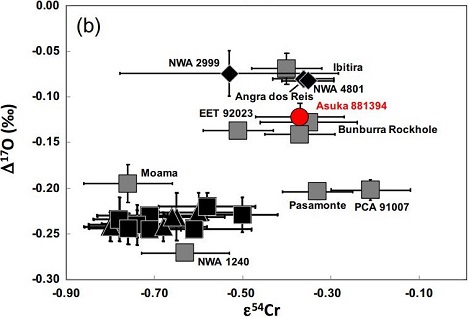
Diagram credit: Wimpenny et al., GCA, vol. 244, p. 487 (2019)
‘Reassessing the origin and chronology of the unique achondrite Asuka 881394:
Implications for distribution of 26Al in the early Solar System’
(https://doi.org/10.1016/j.gca.2018.10.006) Ibitira is derived from in situ crystallizationPhysical or chemical process or action that results in the formation of regularly-shaped, -sized, and -patterned solid forms known as crystals. Click on Term to Read More of residual melts within a magma oceanCompletely molten surfaces of terrestrial planets or moons that formed soon after accretion. Samples returned by the Apollo missions provide evidence of a lunar magma ocean, crystallization of which produced a stratified Moon with a low-density crust formed by accumulation of the mineral plagioclase overlying a higher density mantle of Click on Term to Read More that was subsequently cooled at depth. Studies of the cooling rate and burial depth indicate that initial cooling down to 550°C proceeded at 0.02°C/yr at a depth approximating 30 m, 90 m, or 550 m, corresponding to a 50%-porous regolithMixture of unconsolidated rocky fragments, soil, dust and other fine granular particles blanketing the surface of a body lacking an atmosphere. Regolith is the product of "gardening" by repeated meteorite impacts, and thermal processes (such as repeated heating and cooling cycles). Click on Term to Read More, a compacted regolith, or a solid rock cover, respectively (Miyamoto et al. (2001). Ibitira experienced a very prolonged thermal annealing to a metamorphicRocks that have recrystallized in a solid state due to changes in temperature, pressure, and chemical environment. Click on Term to Read More grade of 5 (Takeda and Graham, 1991), equilibrating pyroxene and forming augite exsolutionSegregation, during cooling, of a homogeneous solid solution into two or more different solids. Click on Term to Read More lamellae. Its igneous crystallization age based on the Pb–Pb age of pyroxene was determined to be 4.5561 (±0.0023) b.y., which is older than most all eucrites (Iizuka et al., 2013). With the determination of a more precisely calculated 238U/235U value, a slightly older Pb–Pb age of 4.55675 (± 0.00057) b.y. was obtained by Iizuka et al. (2014). This age is considered to represent the time of final equilibration during high-temperature metamorphism, probably soon after igneous crystallization. They suggest this stage of thermal metamorphism was initiated when the Ibitira source lavaHot molten or semifluid rock derived from a volcano or surface fissure from a differentiated and magmatically active parent body. Click on Term to Read More flow was buried by subsequent flows. Notably, the Pb–Pb age of Ibitira is virtually identical to its Mn–Cr age, calculated to be 4.5574 (± 0.0025) b.y. anchored to the D’Orbigny angriteType of evolved achondrite meteorite that represent some of the earliest stages of asteroidal differentiation and magmatism in our solar system. Angrites are named for the Angra dos Reis meteorite, which fell in Rio de Janeiro, Brazil, in early 1869. They are basaltic (mafic) rocks, often containing porous areas, and Click on Term to Read More. A subsequent impact heating event may be recorded by Ar–Ar chronometry ~4.49 b.y. ago, possibly representing the onset of a rapid cooling stage at ~850°C (Iizuka et al., 2014).
The Pb–Pb and Mn–Cr ages of Ibitira are identical to the those of the slowly cooled (sub-volcanic and plutonicGeology: Igneous intrusive body that forms when magma is injected into host rocks and solidifies. Plutons occur in the crust of asteroids undergoing differentiation or planets. Named after Pluto, the Roman god of the underworld. Plutonic rocks are the rocks found within a pluton. Astronomy: Category of planet including all Click on Term to Read More) angrites such as LEW 86010, NWA 4801, and Angra dos Reis, measured to be ~4.557 b.y. old (Amelin et al., 2006; Lugmair and Shukolykov, 1998). Ibitira experienced a reheating event to a temperature of ~1100°C when a large impact event excavated this material and formed a craterBowl-like depression ("crater" means "cup" in Latin) on the surface of a planet, moon, or asteroid. Craters range in size from a few centimeters to over 1,000 km across, and are mostly caused by impact or by volcanic activity, though some are due to cryovolcanism. Click on Term to Read More probably hundreds of kilometers wide. The Ar–Ar age of ~4.4858 b.y. might reflect this reheating event, which also resulted in the formation of a Ca gradient in the augite lamella, the recrystallization of plagioclase, and the formation of tridymite. Of possible significance is the existence of a tight clustering of Ar–Ar ages in common with that of Ibitira for a number of unbrecciated eucrites and cumulateIgneous rock composed of crystals that have grown and accumulated (often by gravitational settling) in a cooling magma chamber. Click on Term to Read More eucrites (Bogard and Garrison, 2003). These similar ages are consistent with a major impact excavation at depth on the eucrite parent body, after which rapid cooling brought about the closure of the K–Ar chronometer. It is posited that this ~4.49 b.y. old event produced smaller daughter asteroids (Vestoids) from which unbrecciated and cumulate eucrites were eventually derived. However, this radiometric ageThe age of an object determined by the proportions of its original radioactive elements at the time of object's formation and the decay products of those elements at some period in the future. Click on Term to Read More data appears to contradict much of the diagnostic data presented in the paragraphs above and the presumption that Ibitira formed on a parent body separate from that of other eucrites. The CRE age for Ibitira was estimated through Kr-Kr dating by Shukolyukov and Begemann (1996) at 12.5 (±2.0) m.y., which straddles two CRE age clusters determined for eucrites.
A high temperature environment is indicated by the granoblastic texture as well as the extreme Ti-enrichment observed in Ibitira. Rapid cooling (50°C/yr) of a magmaMolten silicate (rock) beneath the surface of a planetary body or moon. When it reaches the surface, magma is called lava. Click on Term to Read More enriched in CO, CO2, and/or water (~50–200 ppmParts per million (106). Click on Term to Read More) occurred at considerable depth, accompanied by a rapid drop in pressure that promoted the formation of large (up to 0.5 cm diameter) vesicles constituting ~3–7 vol% of the rock (McCoy et al., 2003). The high Ca content of plagioclase indicates that water was present in the magma during vesicleVesicles appear in nature when they are produced within lava (extrusive aphanitic igneous rock) whose dissolved gases come out of solution (are released) due to the drop in pressure during an eruption. The resulting lava solidifies around the gas bubbles capturing their shape inside and outside the rock. Vesicles do Click on Term to Read More formation, and H may have been a minor component of the vesicle-forming gas (Burbine et al., 2006). The subsequent mineral growth that occurred within these vesicles includes titanian chromite, ilmenite, whitlockite, and metallic iron. Tabular silicaSilicon dioxide, SiO2. grains present in Ibitira, which are only present in eucrites with granoblastic textures, reflect high temperature metamorphic conditions; this is consistent with their proposed crystallization from the residual partial melt (Mayne et al., 2008).
The 485 g highly shocked and brecciated achondrite NWA 2824 shows many similarities to Ibitira, including similar oxygen isotope values (see diagram below), and it is considered that these two meteorites may be related and that Ibitira might be an impact melt rock rather than a basaltic lava (Bunch et al., 2009, #5367). 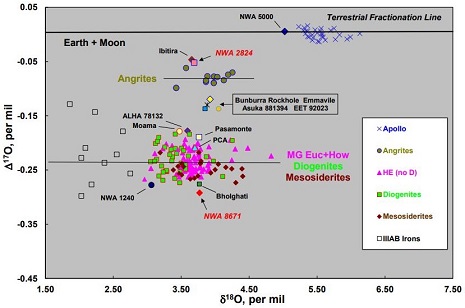 Diagram credit: Irving et al., 49th LPSC, #2247 (2018) The question was raised whether any of the many eucrite and anomalous eucrite-like meteorites now characterized actually derive from dwarf planetThe term "planet" originally comes from the Greek word for "wanderer" since these objects were seen to move in the sky independently from the background of fixed stars that moved together through the seasons. The IAU last defined the term planet in 2006, however the new definition has remained controversial. Click on Term to Read More 4Vesta, or instead, represent numerous diverse parent bodies (Irving et al., 2018). The specimen of Ibitira shown above is a 2.4 g partial slice exhibiting abundant vesicles.
Diagram credit: Irving et al., 49th LPSC, #2247 (2018) The question was raised whether any of the many eucrite and anomalous eucrite-like meteorites now characterized actually derive from dwarf planetThe term "planet" originally comes from the Greek word for "wanderer" since these objects were seen to move in the sky independently from the background of fixed stars that moved together through the seasons. The IAU last defined the term planet in 2006, however the new definition has remained controversial. Click on Term to Read More 4Vesta, or instead, represent numerous diverse parent bodies (Irving et al., 2018). The specimen of Ibitira shown above is a 2.4 g partial slice exhibiting abundant vesicles.






